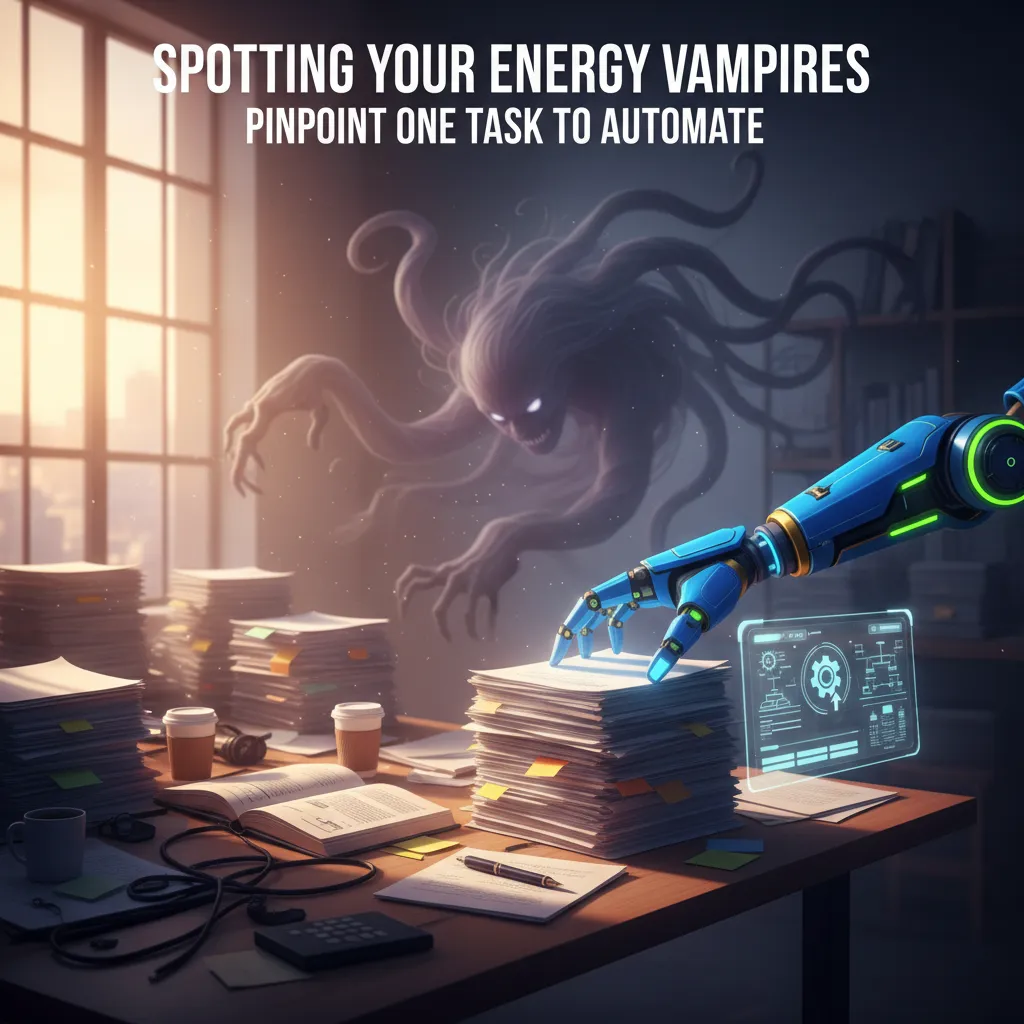Last year, sitting in my cramped home office, I realized something: civilian hustle culture is just another treadmill—same sweat, no sense of mission. That was the moment I observed a friend of mine automate his entire content process, and unexpectedly, he regained time for fishing once more. That's when it clicked: maybe I was working diligently at the wrong things. This post isn't a pipe dream or another productivity hack—it's about building your first AI system, so burnout isn't the badge you wear anymore.
Civilians talk about hustle; veterans know about burnout (why we need AI now).
Four months into my affiliate journey, I hit a wall. It wasn’t the competition or the ever-changing algorithms that nearly made me quit—it was the endless, repetitive DMs. Answering the same questions, writing the same follow-ups, and scrambling for fresh content ideas became a daily routine. I traded military for entrepreneurship, but there was no team to share the burden or mission debrief at the end of the day. It was just me, my laptop, and a growing sense of exhaustion.
Here’s the truth: the biggest threat to veteran entrepreneurship isn’t the competition—it’s burnout from repetitive tasks. In the military, we’re trained to push through discomfort, but in business, that discipline can backfire. Burnout doesn't strike suddenly. Burnout gradually creeps in, as mind-numbing tasks such as daily content, direct messages, and follow-ups gradually sap your motivation.
And it’s not just me. I’ve talked to dozens of veterans who left the service only to find themselves grinding harder than ever, but with none of the camaraderie or mission-driven culture that kept us going. Automation can significantly transform the situation for veterans. A 2023 study found that automation tools save entrepreneurs up to 10 hours per week (source). Imagine what you could do with that time—more strategy, more growth, or maybe just a real weekend for once.
Military culture prizes discipline and systems. We’re wired to build routines that work under pressure. But here’s the secret weapon: translating that mindset into AI-driven automation. When you let AI handle the repetitive stuff—writing content, scheduling posts, replying to common DMs—you’re not just reducing repetitive tasks with AI; you’re reclaiming your energy for the things that matter. As Marcus Evans, a veteran entrepreneur, puts it:
“Automation isn’t about replacing effort, it’s about reclaiming energy.”
The key difference between civilian hustle and veteran entrepreneurship is this: Civilians talk about working harder. Veterans understand that the key to success lies in working smarter, which involves building systems and automating tedious tasks. AI-powered tools don’t just save time; they fill some of those operational gaps left by the absence of a team, helping you build a sustainable online business that grows 30% faster than manual operations.
Burnout is real, but it’s beatable. The mission now is simple: let AI take the repetitive fire so you can focus on leading your business, not just surviving it.

Spotting Your Energy Vampires: Pinpoint One Task to Automate
Let me take you back to the moment I realized I was spending more hours answering the same DMs than actually growing my business. I’d left the military expecting freedom, but instead, I found myself chained to repetitive tasks—just a different kind of grind. If you’re a veteran building an online business, you probably know exactly what I mean. The real enemy isn’t the competition—it’s burnout. And burnout usually starts with what I call “energy vampires.”
Every online entrepreneur has them. For most veterans I talk to, the top three are
Coming up with fresh content ideas every day
Responding to the same DMs over and over
Staying consistent with posting or follow-ups
These aren’t hard tasks, but they drain your energy and kill your motivation. Annoying is what kills discipline. That’s why the first step in online business automation is to spot your biggest energy vampire and make it your “automation test subject.”
Pro Insight: Start Small, Win Big
Ignore the urge to automate everything at once. Trust me, I’ve been there. The key is to pick one stubborn, annoying chore—the one you dread most. For me, it was generating daily content ideas. For others, it might be follow-up sequences or replying to repetitive messages. The trick is to start with the task that makes you want to quit. That’s where AI-powered tools shine.
“Every big system starts with one small task you never want to touch again.” – Riley Matthews, AI Business Strategist
How to Identify Your Top Energy Vampire
Look at your daily routine. Which task makes you sigh or procrastinate?
Consider this: if I were never required to perform this task again, would my day feel more effortless?
Please review your time logs to identify where you might be spending the most time on repetitive tasks.
Veterans in affiliate marketing often cite DMs and content planning as their main drains. Automating just one workflow with AI-powered tools—like using a chatbot for DMs or an AI content generator—can save both your sanity and your discipline. Reducing repetitive tasks with AI isn’t just about saving time; it’s about protecting your drive for the long run.
Remember, identifying that one draining task is the crucial first step before diving into complex AI workflows. Once you automate your first energy vampire, you’ll feel the momentum shift. This is the process by which you begin to construct a business system that serves your needs, not the others.
No-Nonsense Blueprint: Build a Simple, Repeatable AI Workflow
If there’s one thing my military years taught me, it’s that the best systems aren’t complicated—they’re consistent. When I first started building my online business, I wasted hours trying to “do it all.” The breakthrough came when I realized I didn’t need a fancy setup. I just needed an AI-driven workflow that was repeatable, automatic, and predictable.
Why Simplicity Wins: The Three Qualities That Matter
Forget the bells and whistles. Your workflow should do three things:
Repeatable: You can run it every day, no surprises.
Automatic: It works with minimal hands-on time.
Predictable: You know what you’ll get every single time.
That’s not just theory. The Veterans Benefits Administration used hyper-automation to automate 70% of claims processing, slashing establishment time from 27 days to just 12 hours and saving 6.4 million staff hours. Streamlined processes consistently outperform manual ones.
Example: Content Creation Automation in Action
Let’s break down a real-world AI-powered tool workflow for content creation automation:
AI drafts your hooks using proven templates.
AI writes the body of your posts in your voice.
Scheduler posts automatically to your channels.
The AI agent manages replies and DMs, flagging anything you need to see.
You review and refine—the only manual step left.
Here’s a quick story: A buddy of mine, also a veteran, was spending 30 minutes a day just on content. With this setup, he cut that down to five minutes. Now, his routine is background noise, not the main event.
Avoid Tool Sprawl: One Platform, Many Jobs
The biggest trap? Tool overload. You don’t need a dozen apps. Pick one AI-powered tool that handles:
Writing and rewriting content
Planning weekly topics
Repurposing in multiple formats
Automating posting schedules
When your workflow is this tight, you’re not just working smarter—you’re dominating the game.
Always Review and Refine
Even the best system needs a feedback loop. Every week, check what’s working and what’s not. As Jess Tran, Digital Workflow Specialist, says:
“A five-step system beats thirty minutes of daily guesswork—every single time.”
Remember, your system is only as strong as its weakest step. Keep refining, and let AI-driven workflows turn your routine into a non-issue.

Choosing the Right Tool: Less Gear, More Grit
Let me be straight: I once burned a whole week chasing every flashy AI-powered tool on the market. I thought if I stacked enough apps, I’d finally outrun burnout. But all I got was a cluttered desktop and zero progress. The truth hit me hard—one useful tool beats 27 bells and whistles every time. Focus is the secret weapon for veteran entrepreneurs, especially when building an online business or offering AI consulting services.
What Matters Most: Must-Have Features
Here’s what I learned the hard way. The right AI-powered tool should handle:
Content creation (so you’re not staring at a blank page)
Voice-matching rewrites (so your posts sound like you, not a robot)
Weekly topic planning (so you never run out of ideas)
Content repurposing (turn one post into many formats)
Posting automation (so your business runs even when you’re offline)
If your tool can’t do these, it’s not saving you time—it’s just another distraction.
Borrowing from the Best: Veteran-Owned AI Consulting Mindset
Veteran-owned AI consulting firms are leading the charge with simple, secure, enterprise-grade automation. They don’t chase trends—they build systems that work every time. Take a page from their playbook: prioritize security, reliability, and simplicity. Automation platforms like ATOM (VA) and Aptive Resources have shown real-world impact—Aptive, for example, achieved 95% data quality and automated 45% of inbound mail processing for claims using RPA and AI. That’s not just efficiency; that’s freedom.
Your Unfair Advantage: One Rock-Solid AI
Most people are still hustling manually, burning out on repetitive tasks. But with one reliable AI-powered tool, you suddenly have an unfair advantage. You’re not just working harder—you’re working smarter, saving your energy for what really matters: strategy, growth, and the mission ahead.
'If your system can't be managed in under 10 minutes a day, it's too complicated.' – Lee Chen, Veteran Solutions Architect
Wild Card: Your Infinite Patience Digital Assistant
Imagine hiring a digital assistant with infinite patience and zero complaints. That’s what the right AI should feel like for you. It’s not about having more gear—it’s about having more grit and letting technology amplify your discipline.
When you evaluate tools, remember it’s about the fit for your workflow, not what’s trending. Less gear, more grit. That’s how veterans quietly dominate with AI-driven business systems.
The Secret Sauce: Feedback Loops and Small Tweaks (Military Mindset Edition)
There’s a reason veterans thrive with AI-driven workflows: we know that feedback is the oxygen of improvement. In the military, feedback loops are mission-critical—skip them, and you’re flying blind. Civilians often overlook this, but veterans? We build it into everything. That’s the secret sauce for AI systems scalability.
Weekly Rituals: Your New After-Action Review
Every week, I run a simple check-in—my own digital after-action review. I ask three questions:
What content or campaign performed best?
Which tasks still feel like a slog?
Where can automation lighten the load further?
This isn’t busywork. It’s the same principle the Veterans Benefits Administration (VBA) uses. They rely on feedback loops for AI to manage claim surges, adapt automation, and keep human oversight sharp. That’s how they scale without losing control—and it works for online businesses, too.
Story: The Power of One Small Tweak
Let me give you a real example. Three months ago, I started tracking which blog formats got the most engagement. I noticed my “quick tips” posts outperformed longer essays. So, I shifted my content mix—just a small tweak. The result? My audience doubled in ninety days. No massive overhaul, just steady, weekly adjustments.
Small Adjustments Beat Big Overhauls
Here’s what I learned: iteration beats perfection. You don’t need to blow up your whole system. Instead, pick one thing to tweak each week. Maybe it’s your posting schedule, maybe it’s your DM automation. Over time, these micro-adjustments stack up, driving continuous, measurable improvement.
Beware Feedback Fatigue—Keep It Simple
‘Feedback fatigue’ is real. Don’t drown in data. Focus on one tweak per week. That’s how you avoid burnout and keep your AI-driven workflows sharp.
Wild Card: Let Your AI Suggest the Next Move
Want to level up? Ask your AI system: “Based on last week’s engagement, what should I prioritize next?” Let the machine surface insights you might miss. This technique is how you turn feedback loops for AI into a true force multiplier.
“If you’re not learning every week, your system isn’t working.” – Dana Grant, Veteran Process Analyst
Remember: scale comes from iteration, not perfection at launch. That’s the military mindset powering AI systems scalability, and it’s how veterans quietly dominate online business.

"Holding the Line: Treating Your Time as Precious as Ammo"
Military life drilled one lesson into me that I’ll never forget: exhaustion never helped anyone win a mission. In the field, you rationed your energy and your ammo with the same discipline. But when I started my online business, I forgot that rule. I let my calendar fill up with “urgent” tasks—until the day I missed my daughter’s soccer game for a client call that should’ve been automated. Never again.
Here’s the truth: automation isn’t a luxury; it’s the backbone of sustainable entrepreneurship. If you’re serious about time management strategies and using automation to reduce burnout, you have to protect your high-value hours as fiercely as you’d defend your position under fire.
“Automation is how you build a business that doesn’t break you.” – Serena Woods, Veteran Entrepreneur Coach
Time Management Strategies from the Front Lines
Time Blocks: Schedule your day in focused blocks. Guard these like you’d guard your gear—no interruptions, no exceptions.
Rules of Engagement for Manual Tasks: If a task is repetitive and doesn’t require your unique expertise, it’s a candidate for automation or delegation.
Zero-Tolerance for Avoidable Busywork: If you wouldn’t let a leak drain your canteen, don’t let repetitive work leak your hours. Patch those leaks with AI-driven workflows.
Automation to Reduce Burnout: Your New Standard Operating Procedure
Online business automation is your unfair advantage. Tools like AI content schedulers, automated DM responders, and workflow managers are critical for handling the grunt work that leads to burnout. Every minute you save is a minute you can spend on strategy, family, or even just catching your breath.
Boundaries Are as Important as Systems
Military discipline taught us to treat time as a strategic resource, not an afterthought. Set boundaries for yourself and your business. Give yourself permission to automate and delegate relentlessly. If a task doesn’t move the mission forward, it doesn’t deserve your manual attention.
Remember, automation to reduce burnout isn’t optional when you’re balancing work, family, and business. Once you automate, you’ll wonder why you didn’t start sooner. Guard your time like it’s ammo—because in this game, it is.
From Soldier to System Builder: Rethinking Discipline in the Age of AI
If you’ve ever wondered whether those years of 0600 formations and endless checklists would pay off outside the military, let me tell you: this is your moment. Military discipline in business isn’t just a buzzword—it’s the overlooked superpower veterans bring to the table, especially when it comes to building AI-driven business systems. The truth is, structure and follow-through matter more in automation than any fancy hack or bigger budget ever could. In the military, you learned to trust the process, execute the mission, and refine after-action reports. Now, those same habits are the backbone of scalable, AI-powered entrepreneurship.
When I first started building my online business, I thought hustle was everything. But the grind quickly turned into burnout. That’s when I realized: AI gives you leverage, but discipline gives you direction. It’s not about replacing hard work—it’s about making your effort count where it matters most. Stack one system a month, and what once felt impossible becomes inevitable. Every time you automate a task, treat it like a mission update: review, refine, then deploy. That’s how you turn chaos into consistency and consistency into freedom.
Here’s the personal truth I wish someone had told me sooner: automated systems let you use your discipline where it matters, not waste it on what a bot could do. As Miguel Cortez, a fellow veteran business owner, put it,
“Automated systems let you use your discipline where it matters, not waste it on what a bot could do.”
That’s the difference between feeling overwhelmed and feeling in control. Structured processes allow you to adopt AI systems with confidence, knowing that every tweak and every improvement is a step toward greater scalability and operational efficiency.
The real badge of honor? Building a business that runs even on your off days. Your military years trained you for consistency, discipline, and execution. AI gives you the leverage to use all that—without burning out again. Build one system at a time. Stack them for freedom. That’s how veteran entrepreneurship quietly dominates: not with brute force, but with the quiet power of systems that scale. In the age of AI, your discipline is your edge—and your systems are your legacy.



